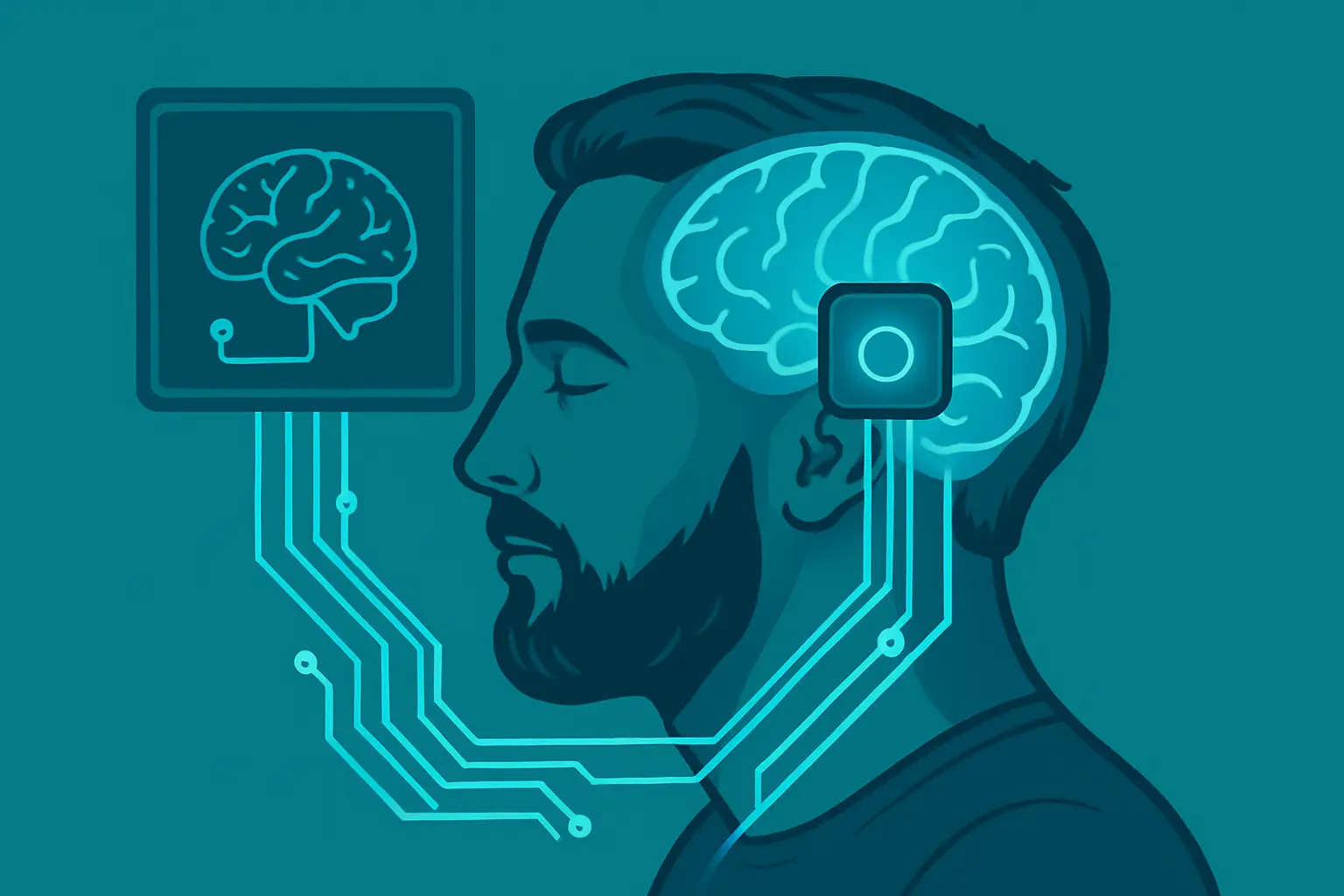Neuralink's First Human Brain Chip : What It Means For The Future
By Amrapali · April 2025

Have you ever imagined controlling a computer or a robotic arm with just your thoughts? It sounds like science fiction, but it’s becoming a reality thanks to advances in brain-computer interface (BCI) technology. Companies like Elon Musk’s Neuralink are leading the charge, developing devices that can read brain signals and translate them into actions. With the first Neuralink human brain chip recently implanted in a human, the future of human-machine interaction is closer than ever.
But how exactly does this work? And what could it mean for people with paralysis, neurological conditions, or even those simply curious about enhancing their cognitive abilities? Let’s explore the fascinating world of BCIs, their groundbreaking innovations, and the ethical questions they raise.
What is a Brain-Computer Interface (BCI)?
A Brain-Computer Interface (BCI) allows direct communication between the brain and external devices, bypassing traditional physical movement. Sensors detect brain activity and convert it into commands, effectively translating thoughts into actions. BCIs are already being used to control prosthetics, restore movement, and provide communication for people with neurological conditions.
For example, in 2012, a paralyzed woman named Cathy Hutchinson used a BCI to control a robotic arm and drink coffee on her own for the first time in nearly 15 years. This groundbreaking moment showcased the life-changing potential of the technology. With advancements like the Neuralink human brain chip, the possibilities are rapidly expanding.
<!– Ad Placeholder –>
<div class=”ad-space” style=”display: none;”>[Ad will go here]</div>
How Do the Sensors Read and Translate Your Brain Signals?
The brain contains billions of neurons that communicate through electrical impulses called action potentials. BCI sensors, typically placed on or inside the brain, detect these impulses. External sensors, like EEG caps, read signals from the scalp, while more advanced implants directly monitor neural activity. Neuralink uses ultra-thin electrodes implanted via a robotic surgeon for precise data collection, ensuring minimal damage to surrounding tissue.
Neurons in different regions of the brain are specialized for specific tasks. For example, the motor cortex is responsible for voluntary movements. When you think about moving your hand, neurons in this region generate distinct patterns of action potentials. BCI systems use machine learning algorithms to identify these unique patterns. Over time, the system learns to associate specific patterns with intended movements, like lifting a finger or moving a leg.
The electrodes capture these electrical patterns, and sophisticated software decodes them into digital commands. The decoded commands are then transmitted to a device, such as a robotic limb or a computer interface, effectively converting thoughts into actions. Continuous feedback helps refine the accuracy of the system, enabling smoother and more intuitive control.
Elon Musk's Neuralink Human Brain Chip: A Revolutionary Step Forward in BCI Innovation
Neuralink, founded by Elon Musk, is at the forefront of BCI innovation. In a groundbreaking development, Neuralink recently implanted its first brain chip in a human, marking a significant milestone. The patient is reportedly recovering well, with early results showing promising functionality. The Neuralink human brain chip, equipped with thousands of tiny electrodes, aims to restore movement in paralyzed patients and potentially treat neurological conditions.
Dr. John Donoghue, a neuroscientist and BCI pioneer, explains, “Neuralink’s approach is revolutionary because of its scalability and precision. The ability to implant thousands of electrodes with minimal invasiveness could open doors to treatments we’ve only dreamed of.”
Musk envisions a future where BCIs not only treat medical conditions but also enhance human capabilities by integrating with artificial intelligence. As Neuralink continues to refine its technology, the potential for even more complex brain-to-device communication will grow.
Click here to know more.
The Medical Potential: Transforming Lives
BCIs hold immense potential in the medical field. Here are some of the most promising applications:
- Restoring Movement for Paralysis: BCIs can bypass damaged nerves to send movement commands from the brain to prosthetic limbs or stimulate muscles directly.
- Treating Neurological Diseases: Conditions like Parkinson’s, epilepsy, and Alzheimer’s could see revolutionary treatments through brain signal regulation.
- Communication for ALS and Locked-In Syndrome Patients: BCIs enable non-verbal individuals to communicate using thought-controlled speech-generating devices.
For instance, researchers at Stanford University recently demonstrated a BCI that allowed a paralyzed man to type by imagining himself writing. The system translated his thoughts into text at a speed comparable to typing on a smartphone.
Click here to know more.
<!– Ad Placeholder –>
<div class=”ad-space” style=”display: none;”>[Ad will go here]</div>
Beyond Medicine: Enhancing Human Potential
Looking beyond medical applications, BCIs may enable seamless communication between humans and machines. Imagine uploading knowledge directly to your brain or sending messages through thought alone. Neuralink’s vision includes cognitive enhancement, improved memory, and even the potential to connect our minds to artificial intelligence systems.
In addition, BCIs may find applications in gaming, virtual reality, and productivity tools, making human-computer interactions faster and more intuitive. For example, a startup called CTRL-Labs (acquired by Meta) is developing a wristband that interprets neural signals to control devices, offering a glimpse into non-invasive BCI applications.
Ethical Considerations: Navigating the Risks
While the technology is groundbreaking, it raises significant ethical concerns. Issues like privacy, security, and data ownership need careful regulation. If brain signals are accessible, how do we ensure they remain secure?
Dr. Anna Wexler, a bioethicist at the University of Pennsylvania, warns, “The potential for misuse of neural data is enormous. Without robust safeguards, BCIs could expose individuals to unprecedented risks, such as hacking or unauthorized surveillance.”
Additionally, the accessibility and affordability of Neuralink-like devices could create inequalities. Should everyone have access to BCIs for non-medical uses? Balancing innovation with ethical oversight will be crucial as technology advances.
The Road Ahead
With Neuralink’s successful implantation, the future of BCIs is closer than ever. The integration of brain and machine could revolutionize healthcare and human interaction. As research progresses, we’ll likely see more advanced applications, opening new possibilities for people with disabilities and pushing the boundaries of human potential.
The era of brain-computer interfaces is just beginning. With continued advancements, the power of the mind is set to become an even greater force of innovation and connection.
What do you think about the ethical implications of brain-computer interfaces? Share your thoughts in the comments. For more such content click here.
<!– Ad Placeholder –>
<div class=”ad-space” style=”display: none;”>[Ad will go here]</div>

